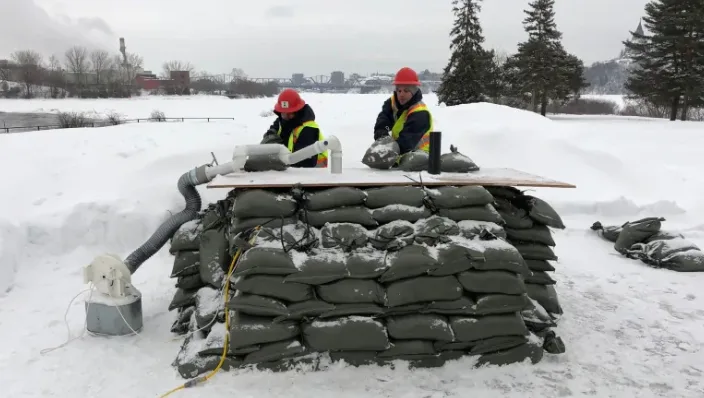
Centuries-old gas canisters buried in Ottawa could explode
This winter, workers 'decommissioned' eight canisters that had been unearthed on Victoria Island and contained a slew of mysterious gases. They'd been buried there for more than a century. (Chris Falconi)
Last summer, during initial work to clean up the soil on temporarily closed Victoria Island in downtown Ottawa, something unexpected happened.
When a backhoe dug into the ground about three metres from shore on the east side of the island, it unearthed what appeared to be three large, badly corroded steel scuba-diving tanks.
Turns out, they'd been buried there for more than 100 years, the byproducts of acetylene gas experiments by inventor Thomas Leopold "Carbide" Willson, whose workshop once sat nearby.
The canisters are dangerous and potentially explosive — and there are believed to be anywhere from 200 to 300 of them underground.
"We believe [Willson] was compressing the gas into cylinders, and he would test them. And when they actually wouldn't work, rather than disposing of them properly he would bury them on the property," said Chris Falconi, whose company, uOttawa Design Services, was later hired to help safely neutralize the cylinders.
"It was a surprise to everybody working on the [remediation] project."
One of the gas canisters that was dug up on Victoria Island. (Chris Falconi)
'VERY DANGEROUS STUFF?'
So what to do?
Military equipment decommissioning experts hired Falconi's company to build a remote-controlled robot to puncture each canister and safely release the unknown concoction of gases inside.
Thomas Leopold 'Carbide' Willson was a noted inventor in the late 19th and early 20th centuries who performed much of his research on electricity and metallurgy in the Ottawa area. (Library and Archives Canada) Most of the taps on the canisters have completely rusted off, so they can't be drained the usual way. And they have to be drained before they can be certified safe for transportation and disposal.
It's careful work.
"We're not 100 per cent sure exactly what is in the canisters.... We know for sure that there is acetylene gas. He was using asbestos as a packing material, and they were also using acetone to stabilize the canister," Falconi said.
"Very dangerous stuff. Definitely stuff that you don't want to be breathing in, but most importantly, they can actually be highly explosive as well."
To deal with the risk, a bunker with sandbag walls and a special air filter was built.
One by one, each canister is fastened to the ground. The drilling robot is attached to the canister via a magnet and drills a tiny hole, releasing the gas.
After enough time has passed, someone in protective gear checks it out and attaches a bigger bit to drill a bigger hole, just to make sure there's no gas left.
During testing this winter, eight canisters were "decommissioned." The real work will get underway this summer.
CAN'T JUST BLOW THEM UP
The amount of gas in each canister varies, Falconi said, so sometimes during testing they could see mere wisps of smokey-looking gas being released via their camera — and sometimes, the gas filled the entire bunker.
Why not just explode them, you might ask?
"As much as we would like to blow them up, if you look around us, we are actually in downtown Ottawa," Falconi said.
"Blowing things up in downtown Ottawa typically doesn't go well."
This article was written for the CBC.










